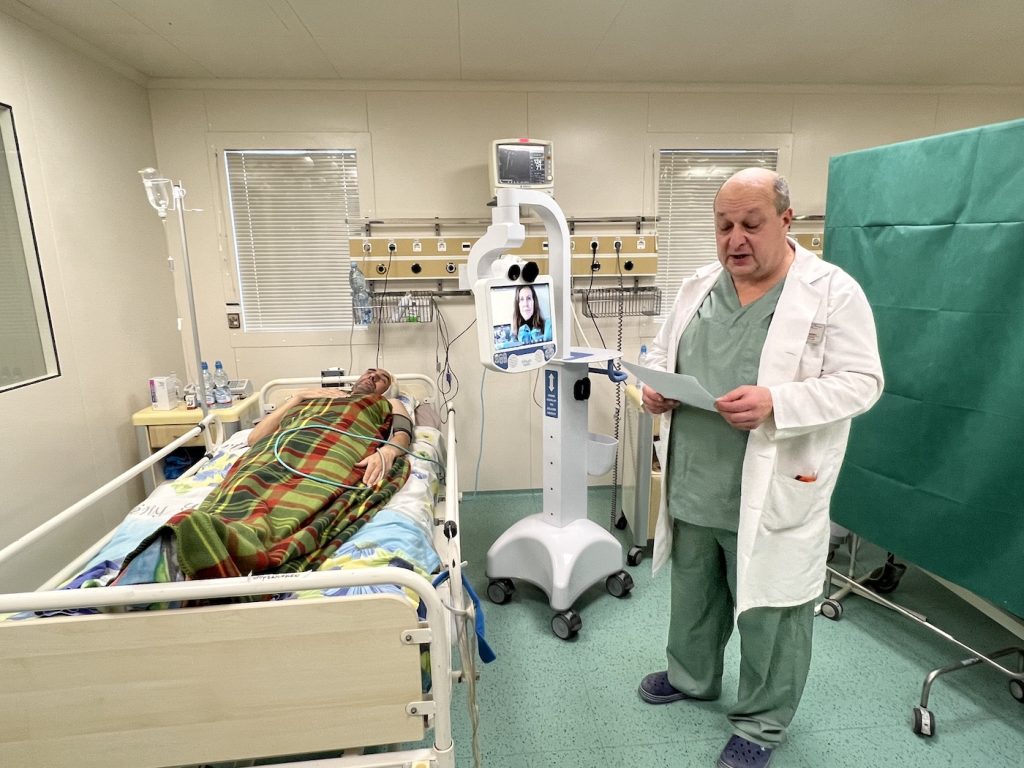World Telehealth Initiative

It took a little while to reach Sharon Allen of the World Telehealth Initiative (WTI) to arrange an interview last week. That’s because the cofounder and executive director of the barely 5-year-old nonprofit was over in Ukraine, in the midst of a week-long visit to the war-torn country as part of a special expansion of World Telehealth’s mission to provide sustained, quality health care through state-of-the-art technology to the world’s most vulnerable communities.
Normally, the organization’s outreach is geared toward more remote places such as Malawi, Bhutan, and Nigeria as the main thrust of its work to bring specialists to patients in areas of need throughout the world where the nearest cardiologist, neurologist, pediatric surgeon or other specialist might be hundreds of miles away, with no means of transportation for patients to get there. Healthcare inequity is a massive problem, and other laudable nonprofit organizations around the world are trying to address it by either delivering medical supplies to the locations or coordinating periodic philanthropic visits by health care experts.
WTI’s method is to create something more sustainable by leveraging telehealth using highly advanced diagnostic and robotic equipment from the world-renowned, locally located Teladoc paired with numerous humanitarian physicians who volunteer their time and expertise remotely, both to examine patients from thousands of miles away and to train the local medical personnel.
“We use medical grade equipment that’s diagnostic enabled, a robotic device that is in the clinic or hospital in these remote locations,” explained Allen. “The devices transmit imaging and more in real time to one of the doctors encompassing 50 different specialties who volunteer to help these communities through upskilling the local providers.”
The experts are supporting the local physician, asking questions, making suggestions, and providing direction as they view the exam in real time.
“The equipment is amazing,” Allen exclaimed. “You can zoom in 26 times, so a remote physician in the U.S. or U.K. or wherever they may be in the world can clearly see what’s happening with a patient. If they put a stethoscope on the patient, you hear it on the headphones at home. Or if they hook up an ophthalmology camera or an ultrasound, we get the images on your screen. You can’t touch the patient, but you can see all of the diagnostic information. It’s as if you’re in the room, but you operate it from a laptop, even an iPhone.”
What were Allen and cofounder Yulun Wang, the board chair and head of R&D at Teladoc Health, doing in Kyiv in the middle of February? In a word: Putin.
The World Telehealth Initiative started working with medical professionals there at the start of the invasion a year ago this week, aiming to reduce casualties from the conflict, Allen said.

“They have amazing physicians in Ukraine, but they hadn’t been prepared for combat trauma, which is a very different thing,” she said. “Normally we take a long time in developing these relationships with our partner hospitals and clinics, but the Ministry of Health reached out to us and asked for help. We had experts who are ex-military special forces doctors who developed the protocols for the U.S. Department of Defense, go to Ukraine a couple of times and do training, but the need is so great, they wanted to support their colleagues there via telehealth.”
The nonprofit shipped 16 Teladoc robotic devices that were rapidly placed in hospitals throughout the country, then augmented those with Microsoft Surface Pro tablets, which can use software to provide remote images and sound.
“The idea for those was to use them on the trains that transport soldiers who get hurt on the front lines, who may have been stabilized by medics but need care in more specialized hospitals in the interior cities,” Allen said. “With the devices, the experts can weigh in on those patients while they’re still hours away on the train, which gets much better results.”
Allen and Wang spent Valentine’s Day hosting a conference in Kiev to expand the program to other medical personnel who haven’t been as quick in adopting remote technology, to share the successes and do some extra training for the physicians.
“It was to incentivize and motivate them to turn the corner on this and be able to use telehealth as the terrific tool that it can be, so simple to use and so effective,” she said. “Renowned neurosurgeons and trauma surgeons were so humbled and appreciative, and were strategizing on the best way for them to support their colleagues that are closer to the front lines and deliver the best for patient care.”
Making it to Ukraine, which involved lots of flying and then a 19-hour train ride from Poland, took a bit of bravery for the WTI team, too. The conference was initially planned for last October but was postponed with little notice when Russia changed military tactics and launched a huge escalation of bombing.
Four months later, the bombing is still happening but on a regular schedule that makes planning possible, she said, though they had a bit of a scare in the country.
“The morning of the conference, we’re running around setting everything up and a siren goes off, but we notice everyone is just going about their business even though there’s an ambulance outside. That seemed a bit weird. Then a doctor came up to us and said there’s no need to be frightened, because they have an app that issues an alert whenever a flight leaves a Russian airfield, and as soon as it crosses the Ukrainian border, they can tell if it is loaded with a missile and where it’s heading. The app updates every 15 seconds, so nobody panics unless they get word that a bombing flight is headed to Kyiv. He said if that happens, we’ll have at least 20 minutes to get to the shelter. But get going, because we’re in the city center and that is the target.”
Fortunately, there were no air attacks, and the conference went off without a hitch, allowing WTI to cement its relationships with its Ukraine partners, which should provide dividends long after the war ends.
“It was incredible to experience that and see what they’re going through living with war every day, and how they keep putting themselves in harm’s way to help, and how grateful they were that we left sunny Santa Barbara to come work with them,” Allen said. “It certainly made me believe in the goodness of people.”
It’s the benevolence of World Telehealth Initiative’s partners and supporters that allows its work to continue, Allen said, with donations going directly to support the cause with little overhead, though the development wing could use a bit more attention.
“Thankfully, the technology and physicians’ time is donated, so it’s just really about shipping and running the operation,” she said. “But to tell the truth, we have focused too much on doing what we’re doing and not enough on the fundraising.”
World Telehealth Initiative
Sharon Allen, co-founder and executive director
Erin Goldfarb, chief development officer
(818) 687-3700
www.worldtelehealthinitiative.org







You must be logged in to post a comment.